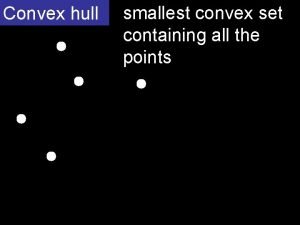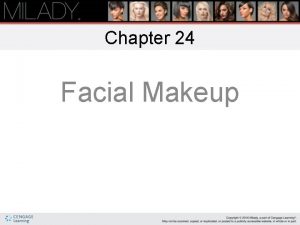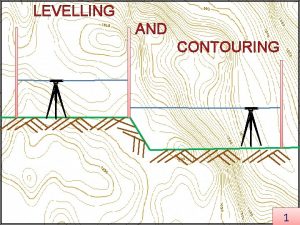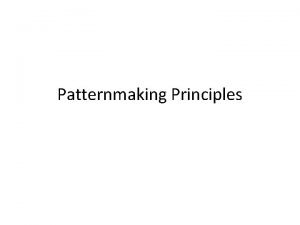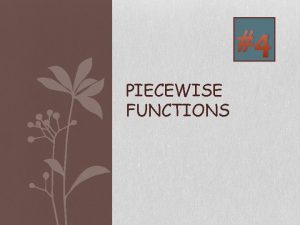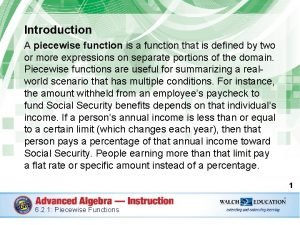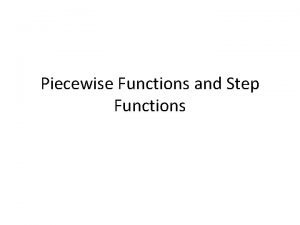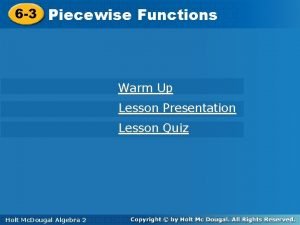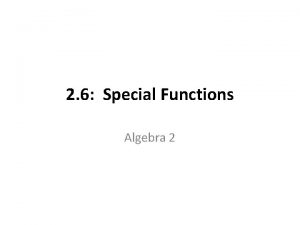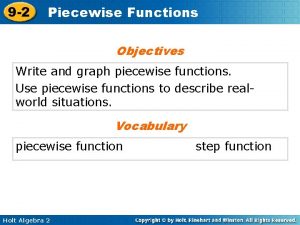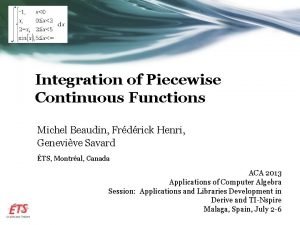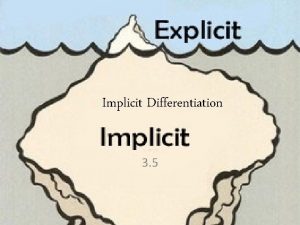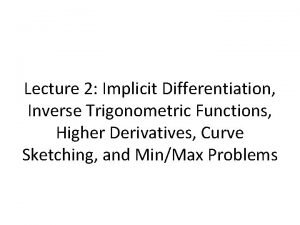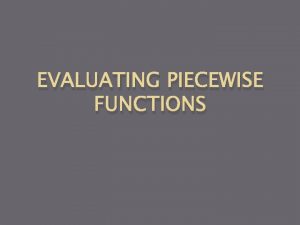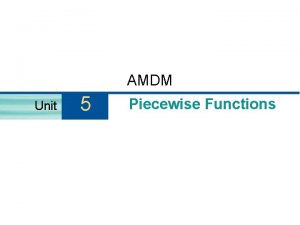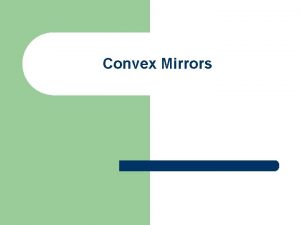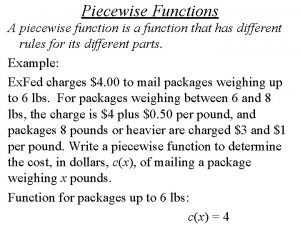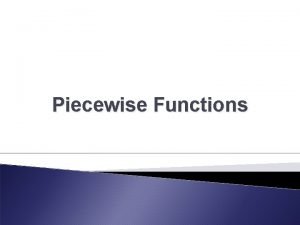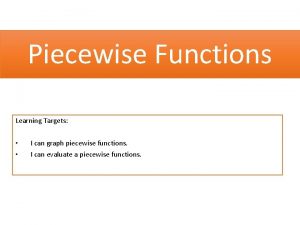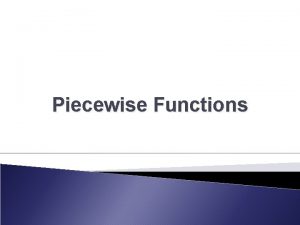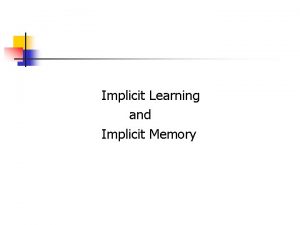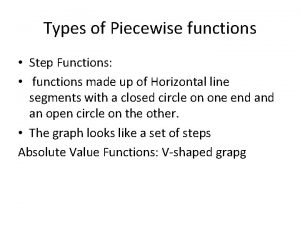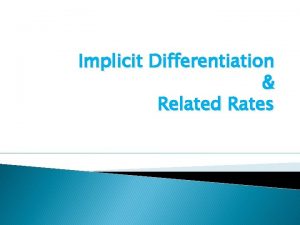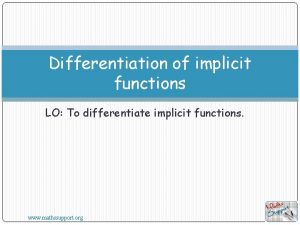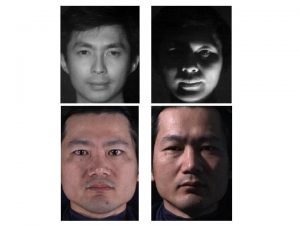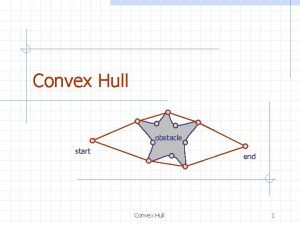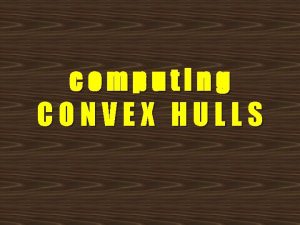Piecewise Convex Contouring of Implicit Functions Tao Ju





















- Slides: 21

Piecewise Convex Contouring of Implicit Functions Tao Ju Scott Schaefer Joe Warren Computer Science Department Rice University

Introduction • Contouring – 3 D volumetric data – Zero-contour of scalar field • Marching Cubes Algorithm [Lorensen and Cline, 1987] – Voxel-by-voxel contouring – Table driven algorithm

2 D Marching Cubes • Generate line segments that connect zero-value points on the edges of the square. – Partition the square into positive and negative regions. – Connected with contours of neighboring squares.

3 D Marching Cubes • Generate polygons that connect zero-value points on the edges of the voxel. – Partition the voxel into positive and negative regions. – Connected with contours of neighboring voxels

Key Idea: Table Driven Contouring • Structure of the lookup table: – Indexed by signs at the corners of the voxel. – Each entry is a list of polygons whose vertices lie on edges of the voxel. – Exact locations of vertices (zero-value points) are calculated from the magnitude of scalar values at the corners of the voxel.

Goal • Extend table driven contouring to support: – Fast collision detection. – Adaptive contouring (no explicit crack prevention).

Idea: Keep Negative Region Convex • Generate polygons such that the resulting negative region is convex inside a voxel. Non-convex Convex

Fast Point Classification • Bound the point to its enclosing voxel. • Build extended planes for each polygon on the contour inside the voxel. • Test the point against those extended planes. Inside negative region Outside negative region

Construction of Lookup Table • In 2 D, line segments are uniquely determined by sign configuration. • In 3 D, polygons are NOT uniquely determined by sign configuration.

Algorithm: Convex Contouring • In 3 D, line segments on the faces of the voxel connecting zero-value points are uniquely determined by sign configuration (table lookup). • Contouring algorithm: – Lookup cycles of line segments on faces of the voxel. – Compute positions of zero-value points on the edges. – Convex triangulation of cycles.

Convex Contouring

Examples using Convex Contouring

Beyond Uniform Grids • Current work: Multi-resolution contouring – A world of non-uniform grids. – In 2 D: Contouring transition squares between grids of different resolutions

Beyond Uniform Grids • Current work: Multi-resolution contouring – A world of non-uniform grids. – In 3 D: Contouring transition voxels between grids of different resolutions

Strategy: Adaptive Convex Contouring • Build expanded lookup table for transitional voxels with extra vertices. • Polygons connected with contours from neighboring voxels. Transition Voxel 1 Transition Voxel 2

Benefits of Adaptive Convex Contouring • Automatic method for computing table • Fast contouring using table lookup • Crack prevention – Contours are consistent across the transitional face/edge. No crack-filling is necessary.

Examples of Adaptive Convex Contouring

Examples of Multi-resolution Contouring

Conclusion • Convex contouring algorithm. – Fast Collision Detection. – Crack-free adaptive contouring. – Real-time contouring with lookup table. • Future work: – Real applications, such as games, using multi-resolution convex contouring. – Topology-preserving adaptive contouring.

Acknowledgements • Special thanks to Scott Schaefer for implementation of the multi-resolution contouring program. • Special thanks to the Stanford Graphics Laboratory for models of the bunny.

temporary
 Concave vs convex shapes
Concave vs convex shapes Convex hull is the smallest convex set
Convex hull is the smallest convex set Absolute value of x as a piecewise function
Absolute value of x as a piecewise function Lash lengtheners that contain fibers
Lash lengtheners that contain fibers Zooming and shrinking in digital image processing
Zooming and shrinking in digital image processing Tacheometric method of contouring
Tacheometric method of contouring Dart manipulation principles
Dart manipulation principles Piecewise function increasing decreasing
Piecewise function increasing decreasing Your cell phone plan costs $75
Your cell phone plan costs $75 Examples of piecewise functions in real life
Examples of piecewise functions in real life Piecewise function generator
Piecewise function generator How to solve piecewise functions step by step
How to solve piecewise functions step by step 1-3 lesson quiz piecewise-defined functions
1-3 lesson quiz piecewise-defined functions Example of a piecewise function in real life
Example of a piecewise function in real life Special functions algebra 2
Special functions algebra 2 Writing piecewise functions from a graph
Writing piecewise functions from a graph Integral of piecewise function
Integral of piecewise function Implicit vs explicit differentiation
Implicit vs explicit differentiation Implicit differentiation with inverse trig functions
Implicit differentiation with inverse trig functions Contoh fungsi eksplisit dan implisit
Contoh fungsi eksplisit dan implisit Nobela ng pilipinas
Nobela ng pilipinas Halimbawa ng melodrama
Halimbawa ng melodrama

